Community Field Experience: Haida Gwaii, BC
I am a UBC teacher candidate specializing in the social studies and IB geography. I am so excited to be in Haida Gwaii at Queen Charlotte Secondary School (QCSS) studying aboriginal education including history, english, geography, anthropology and the Haida language. Additionally, it is a privilege to engage with the community and the natural envirnoment including touring museums, attending performances and dances, hiking and canoeing.
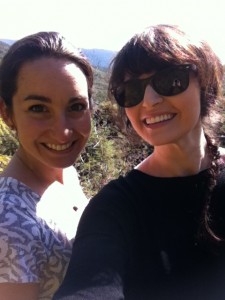
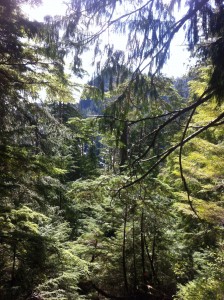
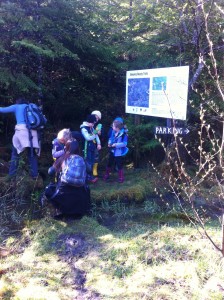
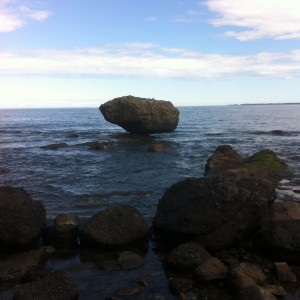
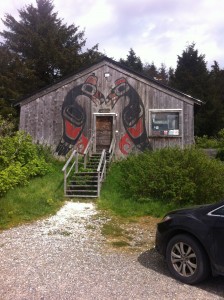
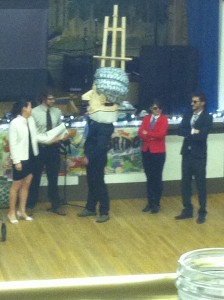
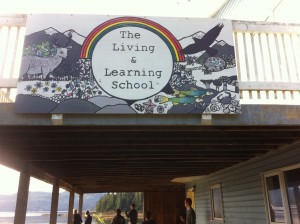
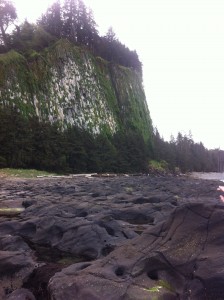
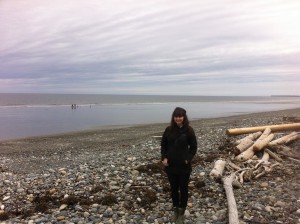
Week One: April 26- May 2
Haida Gwaii is proving to be a place of beauty, adventure and community. Arriving at the school on Monday I knew this would be a very different experience for me than Sir Winston Churchill in Vancouver. I could feel almost immediately its different focuses, goals and ideals, largely shaped by the community that surrounds it. Primarily this week Queen Charlotte Secondary School has opened up my eyes to aboriginal education. Before flying up here I had no idea about courses like BCFN, English First Peoples and Haida classes. However, it has not been the content as much as the delivery and teaching that has been most inspiring. Teaching strategies like using the environment as a classroom, revisiting text time and again to learn new lessons from old words, or listening to elders speak a language only spoken by few, feels to me the heart and spirit of aboriginal education. One exceptional experience at QCSS this week for me included craving a Haida bowl, which will be presented as a gift at a totem pole raising ceremony on June 12. QCSS has commissioned two cravers to create poles representing the Raven Clan and the Eagle Clan. As these poles are placed at the entrance of the school a large potlatch will take place, which will focus on remembering the event and in exchange for witnessing, gifts will be given to community members. These gifts are created on last block on “creative Friday’s”. During this time I learned from a Haida craver the difficulty of creating this art and the patience and respect you need to have to be successful at it. Looking around the wood shop I noticed Haida and non-Haida students alike deeply involved in creating gifts for this ceremony. All around the school others were creating pouches to hold precious rocks or collecting sap from trees to create medicine or using cedar bark to create decorative pins. It is really special to see such strong community within the school and young people working hard at a common and unifying goal.
Following the experiences at school I have been loving exploring Haida Gwaii both physically and socially. We have accomplished only the smallest fraction of what Haida Gwaii has to offer yet have done so much in just one week. I have gone crabbing, canoeing, gone on bike rides and hikes. We have explored Queen Charlotte City, Skidgate and Talell. I explored a beautiful, remote longhouse and walked along the stunning beaches in search for precious agates, a rock that is beloved here.
On Saturday night we went to an event called “Pull Together- Haida Gwaii” which aimed to raise 10,000 dollars in order to pay for legal fees against the Enbridge proposal. It was incredible to be welcomed into the community event and to witness how deeply Haida Gwaiians care for and act as stewards of their environment. It was very interesting for me both as a teacher and lover of geography to witness the physical, spiritual and cultural relationship everyone has to the landscape here in Haida Gwaii.
Overall, the experiences of this week have been pretty exciting and incredible. It is by far the smallest and remote town I have ever stayed in long enough to get to know some names and faces. However, I’m not sure Ive ever been anywhere more social! I am looking forward to the weeks that follow which will hopefully include visiting the elementary school, the independent school, the high school in Masset and participating in some outdoor education.
Week Two: May 3- May 9
This week has been full of new experiences including spending time in the Skidagate elementary school, Sk’aadgaa Naay Elementary, and an alternative private school called the Living and Learning Center. Both of these experiences were my first time working with primary age students in an educational setting. Furthermore, this week we visited the elementary school in Port Clemence and the high school in Masset. On Friday, a professional development day, I toured the local Haida Museum called the Kaay, on the Skidagate Reserve and investigated how language revitalization projects work.
This week has greatly broadened my eyes to different types of teaching, along with different educational settings. The day-to-day classroom of an elementary school teacher is even more different to a high school teacher than I ever thought. Most notably, elementary school classroom management is non-stop and the pace moving from one subject to another is quick and high energy. I really loved observing and participating at Sk’aadgaa Elementary as it was a place that feels warm and welcoming from the second the morning assembly started by acknowledging acts of kindnesses to teachers waving their students goodbye as they hopped on the bus. The small community that this school is situated in means that its community is stronger and closer than most educational environments that I’ve witnessed. It was particularly interesting for me to observe some of the grade 7 students and their typical school experience because it made me appreciate how big of a jump it is moving from a grade 7 classroom to a high school in grade 8.
The small, 22-student alternative elementary school I visited the next day had a strong focus on outdoor education and we ended up going on a fairly difficult hike called Sleeping Beauty with the primary students. At the Living and Learning Center there is only two classes, a k-3 class and a 4-7 class. The students are all basically on their own learning programs for literacy and mathematics because of the variety of ages. The school has chosen not to focus on science or social studies in order to make time for outdoor education. Leaving the school at the end of the day I felt confident that it did not align well with my pedagogical ideals or educational practices. While I had a wonderful day hiking with the students and asking a million questions to the principle I felt as though I would be unsatisfied in a school with less academic focus, even though I understood their idea to encourage more student physical activity and outdoor learning.
One of the most interesting things I’ve realized in all of the schools here in Haida Gwaii is that teachers are far less specialized then they are in larger cities. Teachers have to be open to teaching, coaching or volunteering in a wide range of things outside of their comfort zone. I think it would be very stretching, challenging and exciting to live and teach in a smaller community based on my observations so far.
Outside of school this week we have gone for hikes, visited different aboriginal reserves and attended community events. One notable experience for me this week was attending a viewing of the new Canadian Film Board documentary The Golden Spruce. The Golden Spruce is a local story about a man who cut down a rare and beloved tree by the Haida people to make a statement about poor logging practices in Haida Gwaii. The man who cut down the tree was hated in Haida Gwaii after his action, and his message was lost in the controversy. Watching this film in front of the English director, surrounded by local people who were deeply affected by it and witnessing the dialogue after the movie ended was an interesting and engaging experience for observing community dynamics and local opinions. Later in the week, a community member took us out to hike to the stump of the Golden Spruce. It was quite awesome to experience the hike as it gave me a difference sense of place in Haida Gwaii.
Week Three: May 10- May 15
Getting on the plane home from Haida Gwaii was difficult. I had an awesome last week at Mount Moresby Adventure Camp (MMAC) learning about forestry, biology, and teaching/ leading outdoor educational field trips.
When we arrived at camp with 9 students from Queen Charlotte Secondary we quickly jumped into canoes to explore the lake, while waiting for the 22 students from Masset to join us. It was great to be thrown into an activity right away because it engaged the students and got everyone excited for our stay at MMAC. What I found most interesting were the ways in which the staff at MMAC explained each activity to the students. Each step of the action was explained in a way that grabbed even the most expierenced’s attention, in this instance it was canoeing and every stoke of the paddle was thoroughly discussed. Additionally, the instructions always felt like you were learning more than just a simple stoke of your paddle or a way to change direction, I was also learning about currents, tides, and the structure and building of a canoe. Watching the staff at MMAC give instructions was of real interest to me as it is an area in which I am still constantly learning and one of the challenges of my teaching in which I wish to improve. I will definitely take away direction-giving strategies from the MMAC staff and adopt them into my own practice.
Moreover, a notable staff member at MMAC is named Stu, who is a deeply passionate biologist. His passion is obvious to everyone around him, especially to those who walk with him in the forest and get to witness his incredible knowledge of just about everything we came across. What I found so interesting about Stu is how the students changed their perceptions of Stu throughout the week- in the beginning they thought he, being so passionate about his practice, was a bit eccentric and weird however by the end of the week I heard countless times “Oh, I’ll ask Stu about…” or “I wish Stu were here to explain why…” It was neat for me to see the students change to appreciate his passion and knowledge, something initially they thought was a bit “uncool”.
Outdoor education is really a fascinating opportunity to see students change. During my time at QCSS I was privileged in working in a grade 9 social studies classroom and a grade 9 Haida classroom so I knew how most of the students on the trip acted and participated in normal school life. Throughout the week I watched the students engage in ways I would have never expected knowing them only in the confines of the classroom. Quiet students opened up and tried new things, tough students started to talk and participate with people they don’t necessarily associate with at school and popular students were challenged with characters like Stu who proves being cool comes in many shapes and sizes. In total, the students bonded, the teachers bonded and students and teachers developed meaningful relationships.
Over the course of my last week in Haida Gwaii I realized that I want to be involved in outdoor education in my teaching career. I think it is awesome for teachers to get to know their students and get to challenge them in new ways and spaces, along with giving opportunity for some students to excel outside of classroom confines.
I loved my experiences in Haida Gwaii and in working in a small, rural school district. I am definitely open now to exploring options that I previously deemed as “not for me”. I loved the ability to get to know students more in-depth, become more engaged in the community and feel stretched as a teacher to teach in a variety of positions that are not necessarily my area of expertise. Although I noticed and can identify many challenges that face small communities and remote locations like Haida Gwaii, I think that there is an overwhelming amount of opportunity to grow personally and professionally in a rural teaching position. This experience was amazing for me (and my practice as an educator) and I am very grateful and glad that I seized the opportunity to visit and teach in Haida Gwaii.
My two-practicum experiences were enormously different, one in the largest school in Vancouver the other in a declining school of a 150 students in Charlotte City. The contrast was invaluable to witness, it highlighted that being a teacher can mean so many different things. I also showed me the best and worst of both teaching worlds and how there is so much opportunity in the field of teaching if you are open and willing to it.